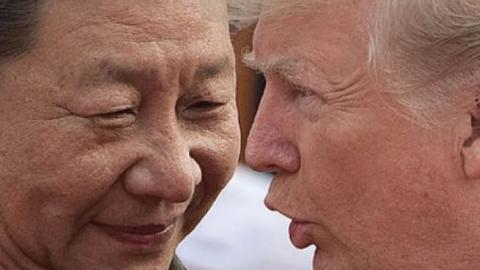China’s Xi Jinping is a confident salesman. He tells Latin American, African and Southeast Asian countries that "Once the water rises, the lotus blooms higher and "When the big river is full of water, the smaller ones will never run dry, and vice versa." Mr. Xi also warns " "one single tree is incapable of blocking the wind.
As one might guess, China is the water and big river and the smaller countries are the lotus and smaller river. China is also the wind and America the lonely tree. These words were used in the context of promoting China’s “ Belt and Road Initiative ” and related plans such as the “ Digital Silk Road, ” with China as the central point of a networked Indo-Pacific.
In and of itself, these sayings do not amount to much, but there is strategy behind these words. The BRI and other Chinese economic plans are designed to bind smaller states in Eurasia to Beijing’s strategic and economic orbit. The bad news is that Beijing’s message is, for the moment, compelling. The better news is that China is becoming increasingly constrained by vaulting ambition and overreach.
Broadly, America and China offer two very different propositions to smaller states. The former champions a rules-based order where all nations have equal rights and privileges under international law. The latter presents a Sino-centric alternative where there is one set of rules and privileges for the Middle Kingdom and another for everyone else.
If smaller states fiercely guard their sovereignty and freedom of action, why would governing elites in these countries remain neutral, or even worse, lean towards China and endorse Sino-centric economic initiatives? This is where Beijing’s carefully constructed narratives, supported by considerable resources, come into play.
Consider the BRI. Beijing is not apologetic that the BRI is China-centric or even that Chinese firms are the primary beneficiaries. Instead, China will flatter these countries in telling them they form essential nodes for a vast China-centric network. The underlying message is that benefits can flow to their country and the entire region only if the great Chinese civilizational state is at the center of economic, political and diplomatic life in the region. This is the intended inference of Mr. Xi’s aphorisms.
In selling the material virtues of a hierarchical Chinese-centric order the main drawcard is the guarantee of benefits to smaller states, in comparison to the uncertain benefits of the American preferred rules-based order. Whereas impersonal and ruthless market-based principles create short-term winners and losers based on the merit-based measurement of profitability and economic efficiency, embracing the Chinese system will give participants guaranteed benefits even if these are unevenly distributed.
This might include Beijing’s largesse in the form of development assistance and grants or an immediate increase in Chinese tourist numbers. The point of depicting opportunity as largesse is that only by submitting to a Sino-centric world can one secure such largesse for oneself. The alternative, according to the Chinese messaging, is to fight the good fight with the lonely tree, America, only to lose out on any special relationship with the future overlord in the region.
As with any expansive strategy, it can only be as good as the resources available. Elite capture and economic investments for strategic purposes is expensive — and this is China’s vulnerability.
Consider how the BRI is funded from the Chinese side. Around 87 percent comes from the country’s state-owned policy and commercial banks. Of the remainder, about 9 percent comes from Chinese commercial firms, 2 percent from multinational financial institutions such as the Asian Infrastructure Investment Bank and 2 percent from the Silk Road Fund.
In other words, 98 percent of the funding comes from China’s already over-leveraged domestic financial and commercial entities, while the Silk Road Funds draws most of its financing from the country’s foreign currency reserves, which will decrease if the Phase One Trade Deal is implemented. Beijing concedes the BRI needs to be commercially viable and more focused on projects that deliver higher quality infrastructure. It cannot survive as a gigantic influence buying program to advance China’s strategic objectives. Yet the BRI is far more attractive to inefficient state-owned than private firms because the former receive more support and cheap finance to take on commercially questionable projects. The majority of BRI projects are unlikely to achieve acceptable return on capital. Despite the clever salesmanship, Mr. Xi is over-promising and under-delivering.
America needs to work with other countries to impose international and established standards and processes that are commercially viable and transparent for all external bidders in strategically important countries such as those in Southeast Asia.
Recent regional polling suggests skepticism of Chinese intentions are growing. The objective is to minimize the Chinese use of opaque deals for the purposes of elite capture, force Chinese state-owned firms to overpay in order to win the contract or push Chinese firms to invest in non-profitable and higher-risk economies.
The BRI began as a plan to export Chinese excess industrial and building capacity and has been rebranded as a grand strategic initiative. If Mr. Xi wants to make a proverbial silk purse out of a sow’s ear, then it is best to ensure China bears the mounting costs of doing just that.
Read in The Hill



















